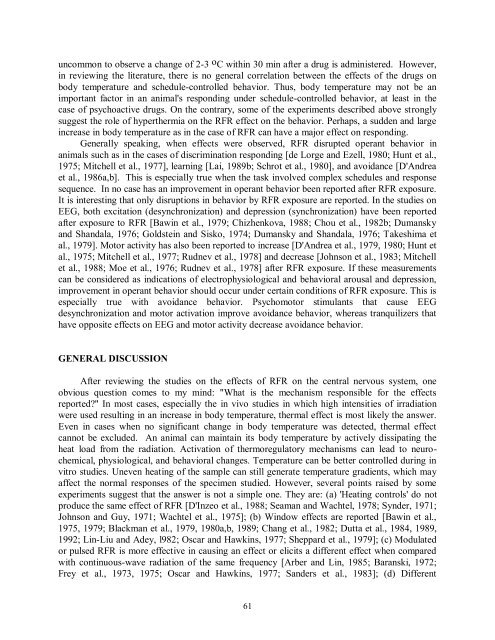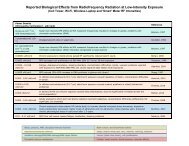Evidence for Effects on Neurology and Behavior - BioInitiative Report
Evidence for Effects on Neurology and Behavior - BioInitiative Report
Evidence for Effects on Neurology and Behavior - BioInitiative Report
You also want an ePaper? Increase the reach of your titles
YUMPU automatically turns print PDFs into web optimized ePapers that Google loves.
uncomm<strong>on</strong> to observe a change of 2-3 o C within 30 min after a drug is administered. However,<br />
in reviewing the literature, there is no general correlati<strong>on</strong> between the effects of the drugs <strong>on</strong><br />
body temperature <strong>and</strong> schedule-c<strong>on</strong>trolled behavior. Thus, body temperature may not be an<br />
important factor in an animal's resp<strong>on</strong>ding under schedule-c<strong>on</strong>trolled behavior, at least in the<br />
case of psychoactive drugs. On the c<strong>on</strong>trary, some of the experiments described above str<strong>on</strong>gly<br />
suggest the role of hyperthermia <strong>on</strong> the RFR effect <strong>on</strong> the behavior. Perhaps, a sudden <strong>and</strong> large<br />
increase in body temperature as in the case of RFR can have a major effect <strong>on</strong> resp<strong>on</strong>ding.<br />
Generally speaking, when effects were observed, RFR disrupted operant behavior in<br />
animals such as in the cases of discriminati<strong>on</strong> resp<strong>on</strong>ding [de Lorge <strong>and</strong> Ezell, 1980; Hunt et al.,<br />
1975; Mitchell et al., 1977], learning [Lai, 1989b; Schrot et al., 1980], <strong>and</strong> avoidance [D'Andrea<br />
et al., 1986a,b]. This is especially true when the task involved complex schedules <strong>and</strong> resp<strong>on</strong>se<br />
sequence. In no case has an improvement in operant behavior been reported after RFR exposure.<br />
It is interesting that <strong>on</strong>ly disrupti<strong>on</strong>s in behavior by RFR exposure are reported. In the studies <strong>on</strong><br />
EEG, both excitati<strong>on</strong> (desynchr<strong>on</strong>izati<strong>on</strong>) <strong>and</strong> depressi<strong>on</strong> (synchr<strong>on</strong>izati<strong>on</strong>) have been reported<br />
after exposure to RFR [Bawin et al., 1979; Chizhenkova, 1988; Chou et al., 1982b; Dumansky<br />
<strong>and</strong> Sh<strong>and</strong>ala, 1976; Goldstein <strong>and</strong> Sisko, 1974; Dumansky <strong>and</strong> Sh<strong>and</strong>ala, 1976; Takeshima et<br />
al., 1979]. Motor activity has also been reported to increase [D'Andrea et al., 1979, 1980; Hunt et<br />
al., 1975; Mitchell et al., 1977; Rudnev et al., 1978] <strong>and</strong> decrease [Johns<strong>on</strong> et al., 1983; Mitchell<br />
et al., 1988; Moe et al., 1976; Rudnev et al., 1978] after RFR exposure. If these measurements<br />
can be c<strong>on</strong>sidered as indicati<strong>on</strong>s of electrophysiological <strong>and</strong> behavioral arousal <strong>and</strong> depressi<strong>on</strong>,<br />
improvement in operant behavior should occur under certain c<strong>on</strong>diti<strong>on</strong>s of RFR exposure. This is<br />
especially true with avoidance behavior. Psychomotor stimulants that cause EEG<br />
desynchr<strong>on</strong>izati<strong>on</strong> <strong>and</strong> motor activati<strong>on</strong> improve avoidance behavior, whereas tranquilizers that<br />
have opposite effects <strong>on</strong> EEG <strong>and</strong> motor activity decrease avoidance behavior.<br />
GENERAL DISCUSSION<br />
After reviewing the studies <strong>on</strong> the effects of RFR <strong>on</strong> the central nervous system, <strong>on</strong>e<br />
obvious questi<strong>on</strong> comes to my mind: "What is the mechanism resp<strong>on</strong>sible <str<strong>on</strong>g>for</str<strong>on</strong>g> the effects<br />
reported?" In most cases, especially the in vivo studies in which high intensities of irradiati<strong>on</strong><br />
were used resulting in an increase in body temperature, thermal effect is most likely the answer.<br />
Even in cases when no significant change in body temperature was detected, thermal effect<br />
cannot be excluded. An animal can maintain its body temperature by actively dissipating the<br />
heat load from the radiati<strong>on</strong>. Activati<strong>on</strong> of thermoregulatory mechanisms can lead to neurochemical,<br />
physiological, <strong>and</strong> behavioral changes. Temperature can be better c<strong>on</strong>trolled during in<br />
vitro studies. Uneven heating of the sample can still generate temperature gradients, which may<br />
affect the normal resp<strong>on</strong>ses of the specimen studied. However, several points raised by some<br />
experiments suggest that the answer is not a simple <strong>on</strong>e. They are: (a) 'Heating c<strong>on</strong>trols' do not<br />
produce the same effect of RFR [D'Inzeo et al., 1988; Seaman <strong>and</strong> Wachtel, 1978; Synder, 1971;<br />
Johns<strong>on</strong> <strong>and</strong> Guy, 1971; Wachtel et al., 1975]; (b) Window effects are reported [Bawin et al.,<br />
1975, 1979; Blackman et al., 1979, 1980a,b, 1989; Chang et al., 1982; Dutta et al., 1984, 1989,<br />
1992; Lin-Liu <strong>and</strong> Adey, l982; Oscar <strong>and</strong> Hawkins, 1977; Sheppard et al., 1979]; (c) Modulated<br />
or pulsed RFR is more effective in causing an effect or elicits a different effect when compared<br />
with c<strong>on</strong>tinuous-wave radiati<strong>on</strong> of the same frequency [Arber <strong>and</strong> Lin, 1985; Baranski, 1972;<br />
Frey et al., 1973, 1975; Oscar <strong>and</strong> Hawkins, 1977; S<strong>and</strong>ers et al., 1983]; (d) Different<br />
61



